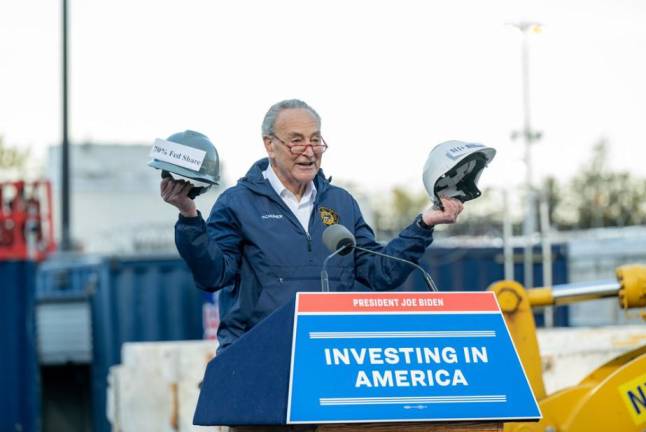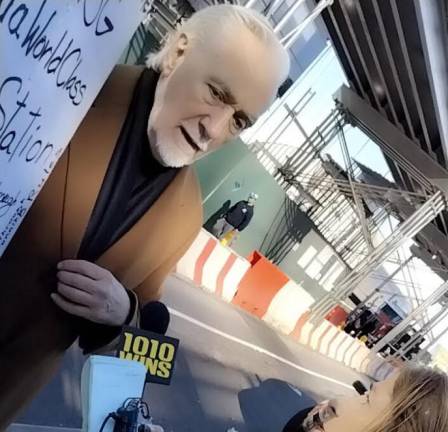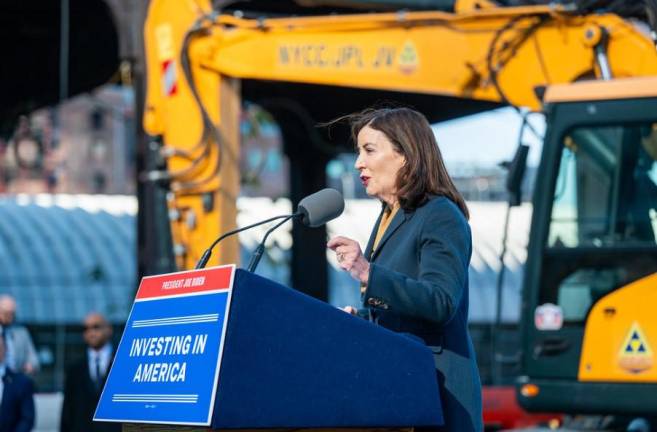Groundbreaking for Hudson Rail Tunnel Draws Politicos and Protestors
The feds are going to kick in 70 percent of the Hudson rail tunnel known as the Gateway Project, but the reality is more trains will not roll into Penn Station until 2038. And no one is saying yet where the extra trains well go in Penn Station.
Officials announced a major step forward on building a new Hudson river tunnel that would double the number of trains that can come from New Jersey, but they left unaddressed the controversial question of exactly where at the already overcrowded Penn Station those trains would go.
Senator Chuck Schumer arrived at a photo opportunity in Hudson Yards with news that the Federal Government would pay a bigger share– more than 70 percent–than previously expected of the $16.1 billion project known as Gateway.
Governor Kathy Hochul said she already had ideas for construction projects the state could fund with the money it would save by the reduction of its share of the Gateway project.
Officials billed the day as the official start of construction of the long delayed Gateway. Schumer and Hochul made their remarks in front of construction equipment gathered as a backdrop to announce the start of a seemingly prosaic piece of the project–a concrete casement to carry trains from the envisioned tunnel through the eastern portion of Hudson Yards.
Along with the start of the casement on the Manhattan side, work began on moving a road on the Jersey side to make way for tunneling.
The tunnel itself won’t be ready for ten years or more, but the casement needs to be built now so it won’t later impede potential plans to deck over the rail yard. The developer, Related Companies, has proposed building a Casino above the yards. Its executives attended the photo opportunity.
The western portion of Hudson Yards was decked over some ten years ago and is now a complex of residential, hotel and commercial buildings. Before that deck was built a concrete casement was built for trains coming through a tunnel that at the time was only a hope.
The casement being started now will connect to the one already built under the western portion of Hudson Yards. But where the trains will go from there is a subject of intense debate.
New Jersey Transit has seemed to favor a plan to expand Penn Station to the south, demolishing the block between Seventh and Eighth Avenues, sometimes described by its tax roll identification, Block 780. Right now that block is populated by small businesses including bars, restaurants, a pizza place, delis, coffee shops, a Meyer’s Parking garage and even St. John the Baptist Catholic Church.
Community and preservation groups fiercely oppose this plan. They gathered outside the gates of Hudson Yards to press their view on Hochul, Schumer and the other assembled officials.
“We reiterated our support for the Gateway Tunnels under the Hudson, but reiterated our belief these tunnels should be connected to the Moynihan Penn Station Complex and not a terminal station with more tracks to the south of Penn Station,” said Samuel Turvey, a leader of the opposition.
A spokesman stressed that the Gateway project was entirely separate from any decision to expand Penn Station.
“There is no question as to where the trains that go through both the new tunnel, and the rehabilitated existing tunnel, will arrive,” said the spokesman, Stephen Sigmund. “They will arrive at Penn Station. From Day 1. And from the day forward. You are correct that at some point in the future Penn Station may be expanded. Even if that happened, they would still arrive at Penn Station.”
The configuration of the concrete casement already built or the one begun last week will not preordain any decisions about how to handle the increased traffic, Gateway officials argued.
Turvey and the other opponents argue that Block 780 can be saved if New Jersey Transit and the other railroads that use Penn Station–the Long Island Railroad and Amtrak–integrate their operations so they run trains through the station rather than terminating their runs there.
This, the argument goes, would increase capacity without increasing tracks and improve service by allowing passengers to take one seat rides from, say, Queens to New Jersey or Seacaucus, NJ to the Hamptons.
Amtrak said last summer that it was reviewing this option as part of an overall environmental review and plans to hold public outreach. But nothing further has been said since.
The chair of Amtrak, Anthony Coscia, said at the event that the expansion of rail capacity made possible by the new tunnel could allow innovations, such as running service directly from Long Island to Washington D.C.
Amtrak trains already run through Queens on their way from Boston to Washington through Penn Station, but they don’t stop there. Amtrak has previously said it would like to extend its intercity service out on Long Island to Ronkonkoma by working with the MTA and its Long Island Railroad “for each provider to expand services on the other’s route” a small version of through running of the sort Turvey and others are arguing for on a large scale.
The bigger question is whether New Jersey Transit and the Long Island Rail Road, run by the MTA, could run trains through Penn Station onto each others services. Andy Byford, the former had of the New York Transit Authority and now head of high speed rail for Amtrak, has supported this concept.
But Amtrak says he is not working on the Gateway Project or the related plans to improve Penn Station.
“The proposed southern expansion of Penn Station doubles down on dated train operating methods at Penn today,” Said Turvey. “Instead of streamlining operations at Penn by implementing the modern methodology of through running, the railroads are opting to expand the highly inefficient use of terminal tracks.
“This means that instead of having trains pass through Penn productively to stops across the region they will sit in train yards or return near empty to their points of origin. This dated model will cost two to three times more than through running, provide poorer service and will require the gratuitous demolition of one block and a half of Manhattan.”
The new Hudson River tunnel has been repeatedly delayed. An earlier plan which would have brought trains in to the north of Penn Station, under Macy’s, was scuttled by then NJ governor Chris Christie. And efforts to revive the project were slow walked by the Trump Administration.
Senator Schumer stressed that the combination of the increased federal financing he was announcing and the start of the casement construction were a signal that the project will now proceed.
The need for the new tunnel was dramatized ten years ago by Super Storm Sandy. Schumer, Hochul and the others were gathered, in fact, in an area that had been submerged by sea water during the storm. The water also flooded the current tunnel, built 110 years ago by the Pennsylvania Railroad.
The damage is so severe that service is frequently delayed and officials worry they might have to shut them down for long term repairs, disrupting an economic lifeline of the northeast.
When the new Gateway tunnel is finished, projected to be in 2035, the old tunnel will be taken out of service for repair. Only after it is returned to service, in 2038, will the full increase in rail capacity be realized.


